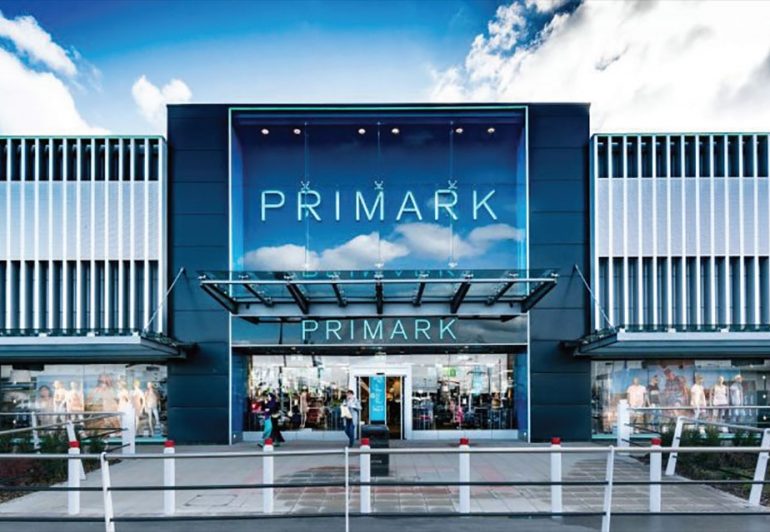Dedicated to the memory of Arthur Ryan, a great retailer and the founder of Penney’s, who passed away at the age of 83.
Breege O’Donoghue, the first, and for 26 years, the only female board member of Primark, is one of the well-known four who created Primark. Today Primark is a leading retailer operating 365 stores across Ireland, Europe, the UK and the US. Always elegantly dressed in Primark and a big fan of Bikram yoga as well as horse riding, Breege is an extraordinary person who has a sensible feel of style. Her look masks her strong personality and firm character, one could easily say that Breege is the most powerful women in Irish retail. Until stepping down recently from her day-to-day role at Primark, Breege was a board member, and held the title of Group Director, Business Development & New Markets. Her name is associated with many of the successful strategies that made Primark a multinational organization and took it international. Today, Breege continues to promote Primark by being a brand ambassador. She is also engaged in promoting Irish design on a global scale as chair of the Design & Crafts Council of Ireland. Breege chairs and is a non-executive director of other bodies, both in the public and private sector.
You are one of four who created Primark. A small Irish company originally known as Penney’s was established by Arthur Ryan and opened its first store in Dublin on Mary Street in 1969.
One individual stands out in the history of Primark, the enigmatic and highly talented, Arthur St. John Ryan. The Primark journey began in 1969 when the company started trading as Penney’s in an old-fashioned department store with mahogany counters at the neglected end of a shopping street on Dublin’s north side. For hard pressed parents with children to clothe, fashion conscious teens and twenty-somethings with little money to spend, and for just about everyone in between. Penney’s was fashion as they had never experienced before, and they took to it like ducks to water. The response “Thanks, Penney’s” when an item of clothing was admired, quickly became a consumer catchphrase and remains to this day. The headline ‘Prada? No. Topshop? No. It’s Primark, darling’, used in a Daily Telegraph fashion column in 2005, echoed this sentiment in the UK.
I joined the company in 1979. Primark was then viewed as a business that would thrive beyond the shores of Ireland. Living on a small island off the northwest coast of Europe, detached from the European continent on one side, and buffeted by the wild north Atlantic on the other, the Irish have always had a taste for travel and broadening horizons. For Primark that was no different, the move into the UK in 1974 followed five years after the first shop opened in Dublin. The next couple of decades were spent building and consolidating in Ireland and in the UK before taking on the next challenge of continental Europe.
In the early seventies, following the opening of Penney’s in Aberdeen in Scotland, America’s JC Penney woke up to what it saw as the illegal use of its name in the UK and Ireland. It took the company to court in Edinburgh in Scotland. Following prolonged legal action, an agreement was reached with JC Penney under which the Irish company would continue to trade as Penney’s in Ireland but would not use that as its trading name outside Ireland. It adopted the new persona of Primark. The name was one in a long list of possible alternatives produced within the company and found widespread acceptance as conveying a premium kind of feel without any specific combination of words.
Primark sells best value clothing internationally, yet it is operating in countries with some of the highest GDPs. What is Primark’s expansion strategy and why does it not open branches in third world countries, where the demand might be higher due to the affordable prices?
Primark continues to explore opportunities to bring the unique offer of “Amazing Fashion, Amazing Prices” to new markets across Europe. The company now has 80,000+ employees, with 365 stores operating across eleven countries, and in excess of 13 million sq. feet of retail space.
Going into a new market, performing due diligence, preparation, understanding the market – customer behavior; shopping behavior and culture – are always challenges. To promote the real Primark story and customer experience, one has to work hard to nurture trust with governments, business influencers, businesses themselves, educational establishments, universities, colleges, schools and fashion establishments, as well as local communities, especially the media.
Who would you regard as Primark’s main competitors?
Competitors are everywhere in many countries and they vary from country to country. Primark loves competition, the more competition, the better retailers we all become. Primark enjoys a loyal fashion following, and the brand boasts over ten million followers across its social media platforms. Primark is the number one volume retailer in Ireland, UK, Spain and Portugal.
Prices are very low; prices range from 35 euros for coats to 1-euro flip-flops. How does Primark earn high profits?
Primark maintains price leadership in every market. It is a volume business. Approximately 1.5 million customers visit Primark shops daily. With a unique combination of the latest fashion and lean operations, Primark offers customers quality and up to date designs at value for money prices. Primark’s Buying and Merchandising teams travel internationally to source and buy garments that best reflect each season’s key fashion trends.
Primark orders large quantities of merchandise as far as possible in advance for the planning of production. For example, one supplier in China once told me: “My business is like 100 bed hotel, I reserve 60% of it for Primark, which I have done for in excess of twenty years as Primark’s order is guaranteed, and they will pay overheads including wages and expenses”.
Primark spends very little money on advertising, thus keeping costs down, and like other fashion retailers, many products are made in developing countries, sharing 98% of factories with other High Street brands.
Considering the number of countries where you operate and their different culture. Do you adjust products to their needs?
Doing business locally but thinking globally is essential. Fine tuning may be necessary, such as color trends in different countries, or geographical location; for example, swimwear will sell all year round in the Canary Islands. When Primark launched its first store in Spain in 2006, fuzzy socks were in high demand because of all the marble floors and were purchased all year round by Spanish customers.
There is always controversy about low-cost retail stores whose products are not made ethically. How does Primark manage to stay ethical and produce low cost clothing?
Primark’s approach to CSR is framed by 5 strategic pillars – its people, its customers, its supply chain, its neighbors and the environment. Turning commitment to ethics, Primark has been working hard for many years to ensure that its products are made with respect for workers’ rights and the environment. Primark standards are set out in its Code of Conduct, which requires all suppliers to comply with as a condition of doing business. It meets international standards and sets out the core principles regarding working conditions, working hours, fair wages and workers’ rights. Primark carries out frequent inspections of suppliers to ensure the Code of Conduct is being enforced, and that workers are being treated properly. This work is overseen by the Primark Ethical Trade and Environmental Sustainability team made up of 100+ specialists based in key sourcing countries. Primark is rigorous in its approach to standards, and only selects and works with factories following successful rigorous due diligence.
Primark recognizes that no one retailer alone can have a positive impact on an entire industry, so to effect change and make an impact beyond direct influence, Primark collaborates with a large number of organizations including Governments, NGOs, charities and other brands to help address issues across the supply chain. Primark has been a member of the Ethical Trade Initiative promoting respect for workers’ rights since 2006 and has ranked as the leader since 2011. Primark collaborates with government organizations including the UK’s Department for International Development and Germany’s partnership for sustainable textiles (Textilbundis).
What about doing business with Georgia from the manufacturing side?
Primark already has partnerships with many experienced manufacturers; these excellent and valuable relationships have existed for over thirty years.
How do you see the fashion industry developing over time?
In the current turbulent environment, strengthening customer loyalty is increasingly about demonstrating to the empowered consumer that the retailer understands his or her preferences on lifestyles, and can anticipate changes in this. A fundamental demonstration of such understanding would come from eliminating merchandise the customer doesn’t want and focusing on what is relevant to him or her. The customers’ loyalty will be routed in trust that the retailer is able to do this range editing. Achieving such focus will not come easily, it will involve not only using information technology to monitor consumer behavior, but also using communication tools to understand consumer preferences and lifestyle choices.
When I was an intern at Primark in the summer of 2017, I saw nothing I expected to see from a typical fashion retail company. The four floor HQ on Mary Street (right on top of the first Penney’s store) looked more like a tech-company’s office, with an open space reflecting the company’s dynamism and it creates a vibe of fast changing fashion. The employees can enjoy a gym with yoga classes and many other activities, as well as a coffee area right next to Primark’s design studio. The creative team can easily visualize their ideas on mannequins and a massive wall, which captures the daily changing trends of fast fashion. The working atmosphere is rather relaxed with employees all dressed in Penney’s clothes mirroring the catwalk looks. Going down to the shop, I fell into the buzz of what is called a Primania. Thousands of customers walking into the store, holding at least five products and standing at the queue filled with the joy of amazing fashion at amazing prices. In the middle of the shopping floor, Primark has beauty salon that offers a wide range of beauty treatments, from getting your nails done to eyebrow threading.
Breege, your personal story is fascinating. You were born in the rural Ireland, after graduating from school even though you wanted to you could not afford to go to college, and yet you became one of the most successful business leaders in Ireland and have built a global well-known brand. How did you achieve all that?
I went to school through fields, but I grew up with the belief that education is key. I was lucky to spend seventeen years working in a hospitality business. With the company I was with, I worked in Switzerland and Germany; where I learned European languages. This European experience became an eye-opener for me. Those years strongly influenced my later life. I have to say, I did not really face too many obstacles on the way, I always worked hard to achieve goals and actively engaged in self-development. Only two years ago, at the age of 73, I completed a Chartered Director Programme – I thought I knew it all in practice, but I wanted to learn it in theory. Besides being involved in Primark, I was, and am a board member of many Irish, state and privately-owned companies.
How do you encourage women who are only now starting their careers?
Be true to yourself, show courage, independence, initiative, appreciate the need to recognize, respect and value differences. Know right from wrong, be ethically aware. Be satisfied only with the very best, do not be clothed in power and status, but generous in heart, mind and spirit and yes, it is encouragement and love that inspire people to succeed and be happy the world over.















